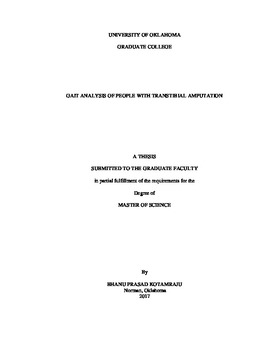| dc.description.abstract | Causes of transtibial (below knee) amputation vary from traumatic events such as accidents to vascular and circulatory disorders. Following amputation, the individual is fitted with a prosthetic device in order to regain mobility. However, the extent of recovery depends on factors such as prosthetic socket fit, functionality of the prosthetic device, the type of amputation and the individual’s health. Prior research was undertaken to study the asymmetry in gait, energy consumption and muscle activity in intact muscles of traditional amputees. Recently, research into residual muscle activity and residuum socket interface force in amputees with transtibial osteomyoplastic amputation has been undertaken. However, very little research has been undertaken to compare the residual muscle activation in unilateral transtibial traditional amputees and in those with unilateral transtibial osteomyoplastic amputation. Furthermore, the correlation between residual muscle activation, residuum socket interface force and the type of gait in individuals with unilateral transtibial osteomyoplastic amputation has never been studied. Study of residuum socket interface forces and residual muscle activity is important because these two parameters have been linked to factors that increase the risk of injury to the residual limb. Furthermore, study of residuum socket interface force helps a prosthetist better understand the loading in the prosthetic socket during gait and helps in achieving better prosthetic socket fit. Study of residual muscle activity patterns also helps in determining the effect of amputation on residual muscles and in turn on the health of the individual. Transtibial osteomyoplastic amputation is known to provide the amputees with distal end weight bearing and restoring the length tension relationship in the residual muscles and has been verified in the previous studies. However, a comparison between results observed after transtibial traditional amputation and transtibial osteomyoplastic amputation have never been studied. Such comparative studies provides insight into the type of prosthetic design that best suits each type of amputation and also provides a better understanding of advantages and disadvantages of each type of amputation.
Gait is an important factor that affects residuum socket interface force and residual muscle activation. Study of the dependence of both these factors on the type of gait is of importance to develop better rehabilitation techniques and improve the performance of prosthetic devices.
In this thesis, the residual muscle activation in transtibial osteomyoplastic amputees and transtibial traditional amputees is looked at. For this purpose, 10 transtibial osteomyoplastic amputees and 4 transtibial traditional amputees were recruited for the study. This would help in realizing the effect of amputation on residual muscle activity and lays the foundation for understanding the effect of amputation on residual limb health. We expect to see considerable residual muscle activity in the transtibial osteomyoplastic amputees and minimal or random muscle activity in transtibial traditional amputation. Furthermore, the co-relation between residuum socket interface (RSI) force and EMG to the type of gait is studied in transtibial osteomyoplastic amputees. For this purpose, 10 transtibial osteomyoplastic amputees were recruited for this study. We expect to see increasing RSI force and EMG activity while comparing self-selected gait, brisk gait and weight carry gait. This would help establish a co-relation between RSI force and EMG activity laying foundation in developing better rehabilitation techniques and prosthetic devices. | en_US |
